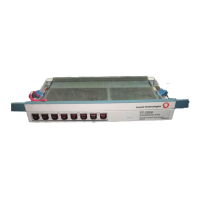About This Document
Issue 8.0 July 2002
xxxv
Lightwave Safety Guidelines
General Laser Information
The FT-2000 OC-48 Lightwave System and associated optical test sets use
semiconductor laser transmitters that emit light at wavelengths between
approximately 800 nanometers (nm) and 1600 nm. The emitted light is above the
red end of the visible spectrum, which is normally not visible to the human eye.
Although radiant energy at near-infrared wavelengths is officially designated
invisible, some people can see the shorter wavelength energy even at power
levels several orders of magnitude below any that have been shown to cause
injury to the eye.
Conventional lasers can produce an intense beam of monochromatic light.
Monochromatic light is a single wavelength output of pure color that may be
visible or invisible to the eye. A conventional laser produces a small-size beam of
light, and because the beam size is small the power density (also called
irradiance) is very high. Consequently, lasers and laser products are subject to
federal and applicable state regulations as well as international standards for their
safe operation.
A conventional laser beam expands very little over distance or is said to be very
well collimated. Thus, conventional laser irradiance remains relatively constant
over distance. However, lasers used in lightwave systems have a large beam
divergence, typically 10 to 20 degrees. Here, irradiance obeys the inverse square
law (doubling the distance reduces the irradiance by a factor of 4) and rapidly
decreases over distance.
Lasers and Eye Damage
Light energy emitted by laser and high-radiance light-emitting diodes (LEDs) in
the 400- to 1400-nm range may cause eye damage if absorbed by the retina.
When a beam of light enters the eye, the eye magnifies and focuses the energy,
magnifying the irradiance. The irradiance of the energy that reaches the retina is
approximately 10
5
or 100,000 times that at the cornea, and if sufficiently intense,
may cause a retinal burn.
The damage mechanism at the wavelengths used in telecommunications is
thermal in origin, for example, damage caused by heating. Therefore, a specific
amount of energy is required for a definite time to heat an area of retinal tissue.
Damage is not instantaneous. It occurs only when one looks at the light
sufficiently long enough that the product of the retinal irradiance and the viewing
time exceeds the damage threshold. Light energies above 1400 nm would cause
surface and skin burns and do not affect the retina.

